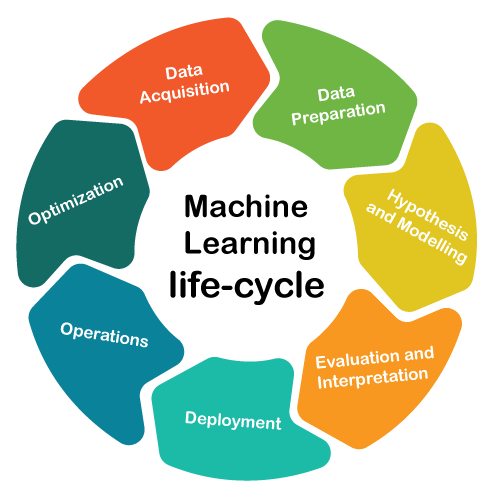Machine Learning Life Cycle
Life Cycle of Machine Learning
Following are the major steps that are involved in the machine learning life cycle:
- Data Acquisition
- Data Preparation
- Hypothesis and Modelling
- Evaluation and Interpretation
- Deployment
- Operations
- Optimization

Data Acquisition
Data is one of the essential components in the life cycle of machine learning, but we must acquire appropriate data to solve one particular problem. It does not require any data scientist to gather the data. Anyone who has prior knowledge regarding the actual difference between the several data sets that are freely available and who knows how to make hard-hitting decisions about any organization’s investment strategy will serve best for the data scientist's role.
Data Preparation
This may be the most tedious and time-consuming task in this cycle, which involves identifying various data quality issues. Usually, whenever the data is acquired, it cannot be analyzed as it might comprehend misplaced entries, irregularities and semantic errors. Thus, to use such kind of data, the data scientists reformat and clean the data manually by either editing it in the spreadsheet or simply by scripting the code. Another name of the data preparation step is the data cleaning or data wrangling phase.
Hypothesis and Modeling
This is the fundamental step of any data science project, which undergoes the process of writing, running and refining the programs for the sake of analyzing and deriving a meaningful business insight from the data. These programs can be written in languages like Python, R, MATLAB or Perl. In this step, we use our data to train various machine learning algorithms and select the one which results in the best performance.
Evaluation and Interpretation
After training the model on data, we evaluate the end result to see how well it performed or how reliable it is in real-life situations. Each performance metric has a distinct evaluation metrics. For instance, if you want your machine learning model to predict the daily stock, then it is highly recommended to consider the RMSE (root mean squared error) for the evaluation. Else, we consider performance metrics like average accuracy, AUC and log loss order for classifying spam emails.
Deployment
The term deployment can be defined as an application of a model that makes the prediction by means of the new data. Building a model is generally not the end of the project. Even though the purpose of the model is to intensify the data’s knowledge, the gained knowledge has to be organized and presented in such a way that it can be easily used by the customer. It is important to be noted that the deployment phase can either be as simple as creating a report or as tricky as employing a replicable data science process as per the necessities.
Operations
In this step, a plan is developed for supervising and upholding the project of data science for a long time. Basically, in this phase, it monitors the performance of the model in terms of upgrade and downgrade. Data scientists take help from an individual data science project for shared learning and to boost up the implementation of alike data science projects in the coming future.
Optimization
Optimization is the last phase contained in any data science project. It reinstructs the machine learning model in production when new data sources are coming in or take necessary steps for upgrading the performance of the machine learning model.